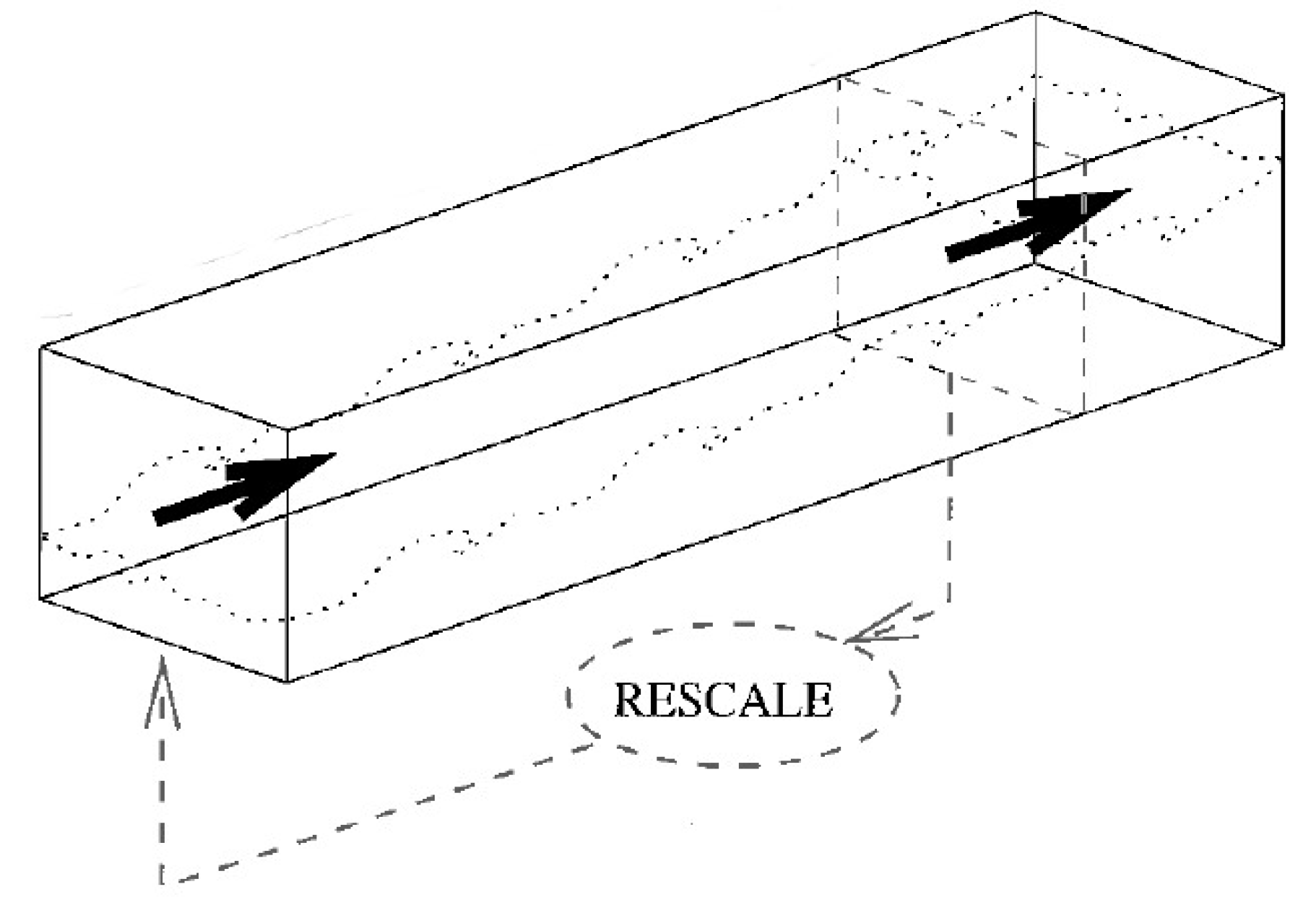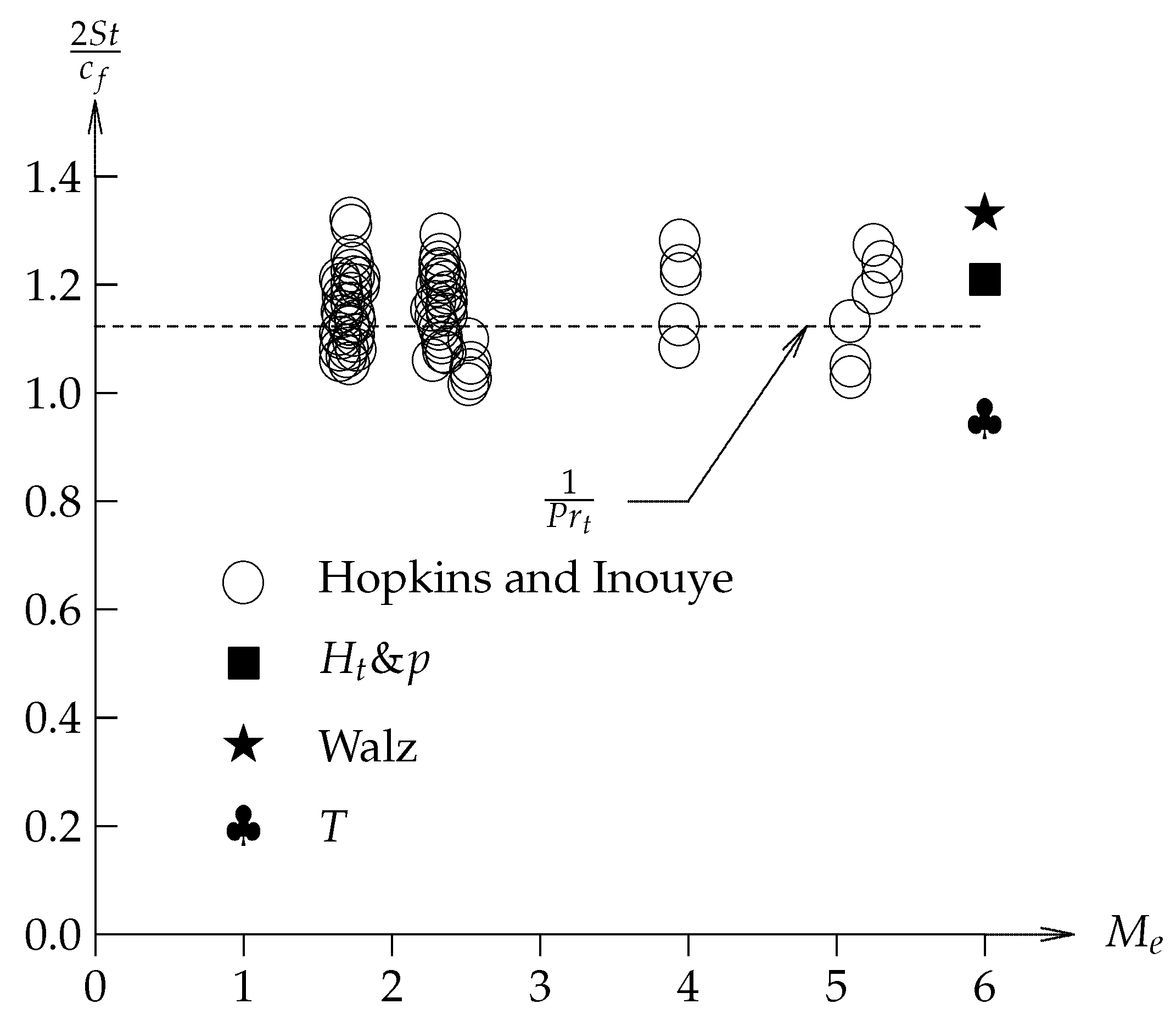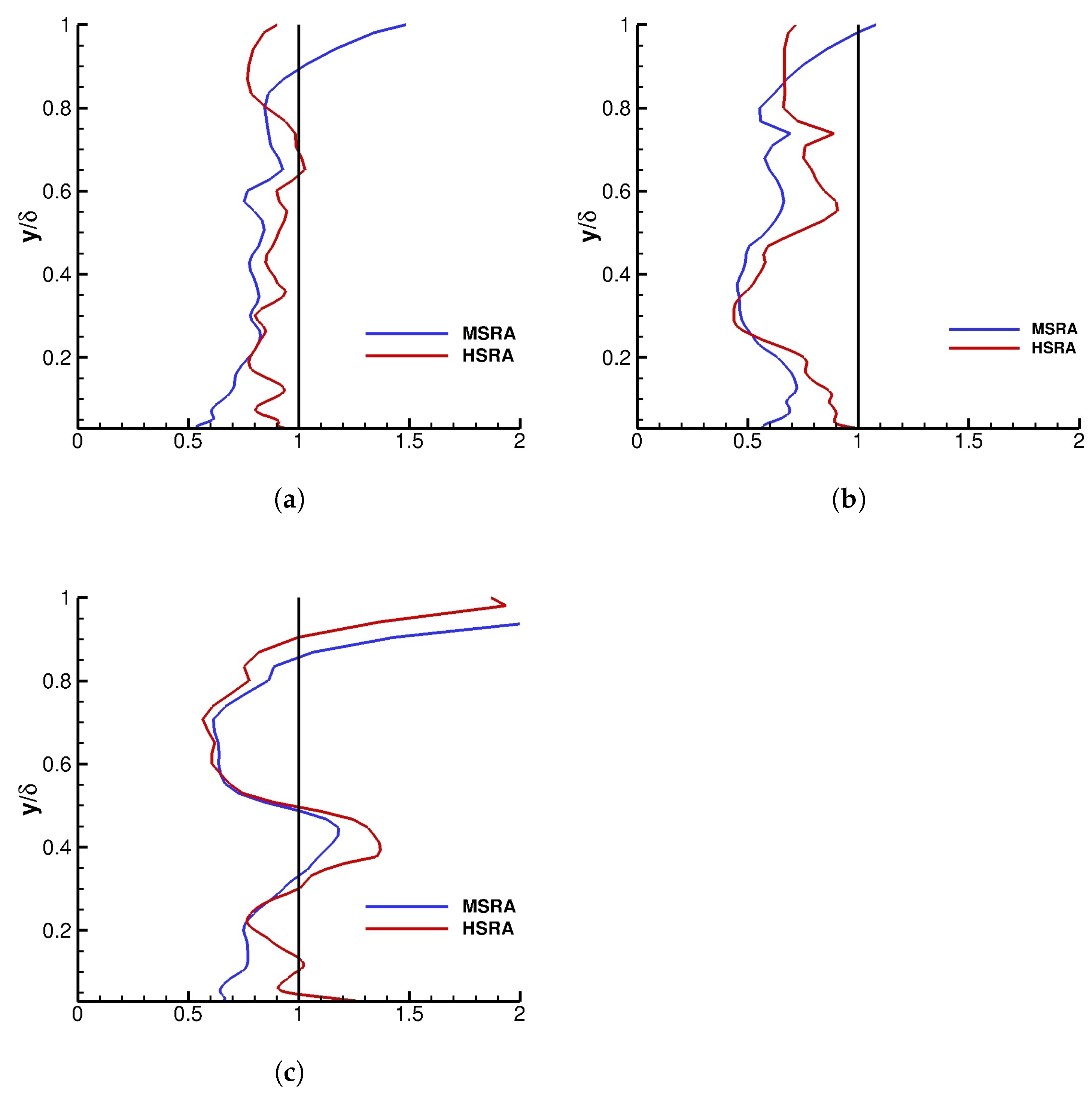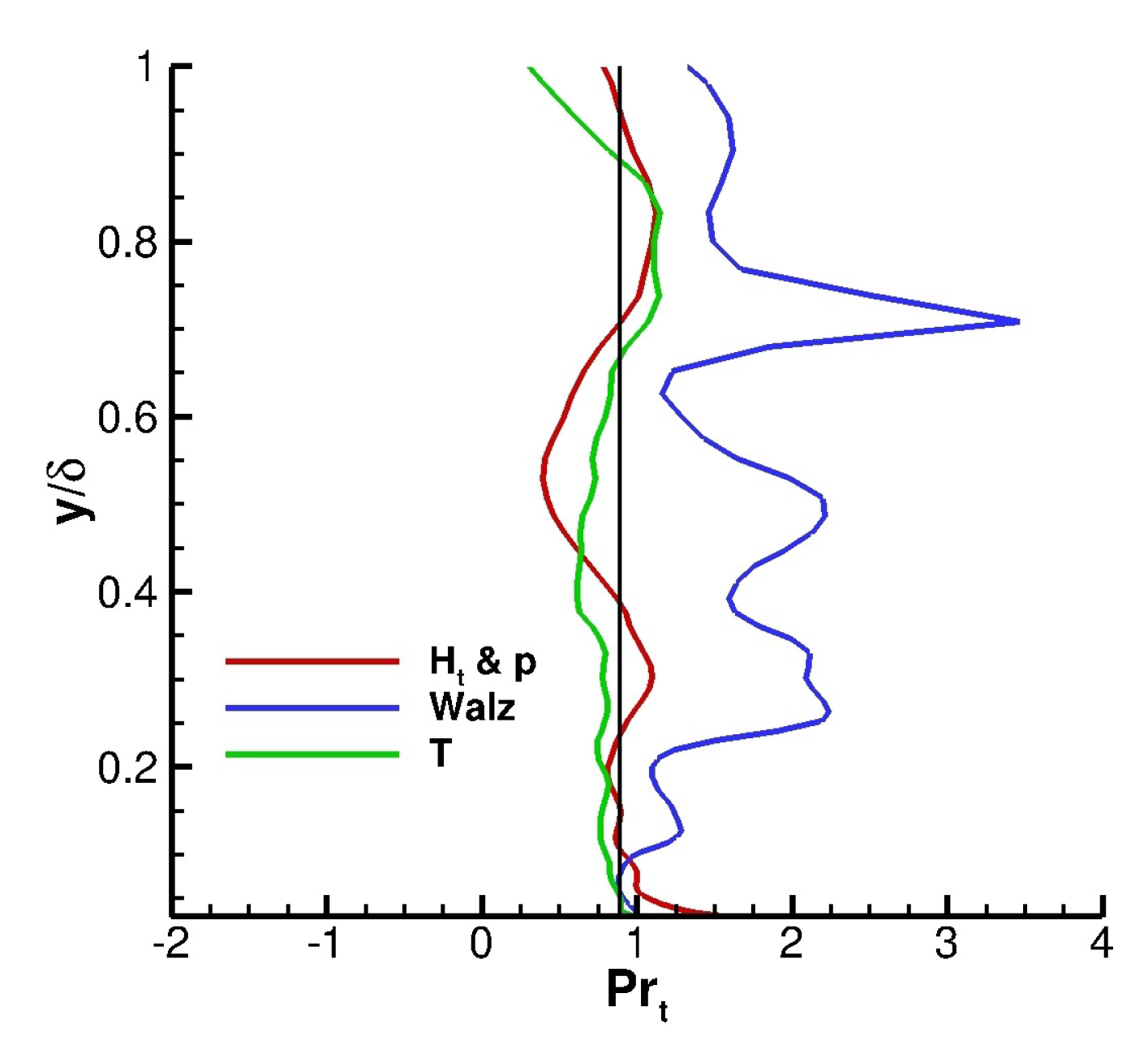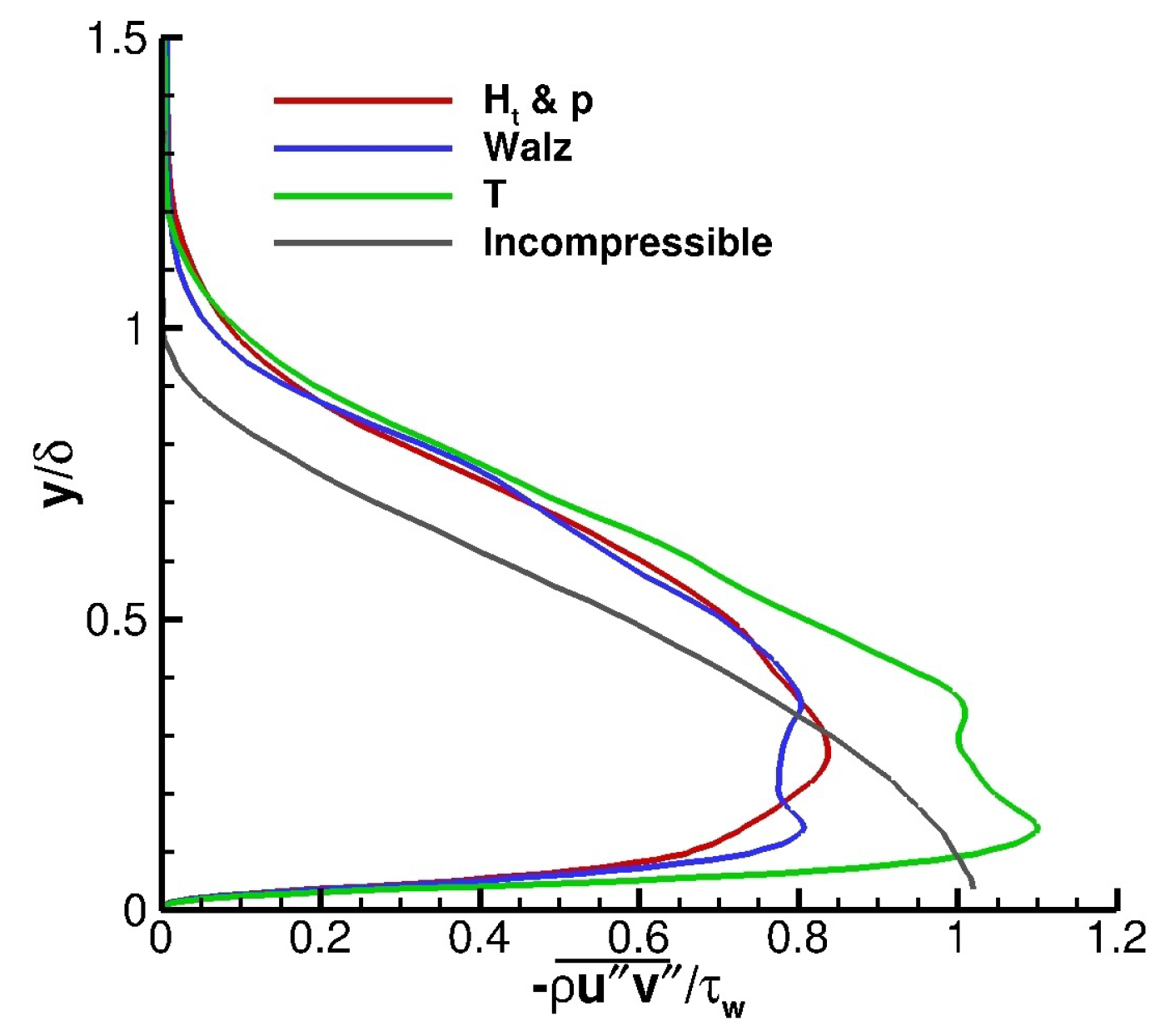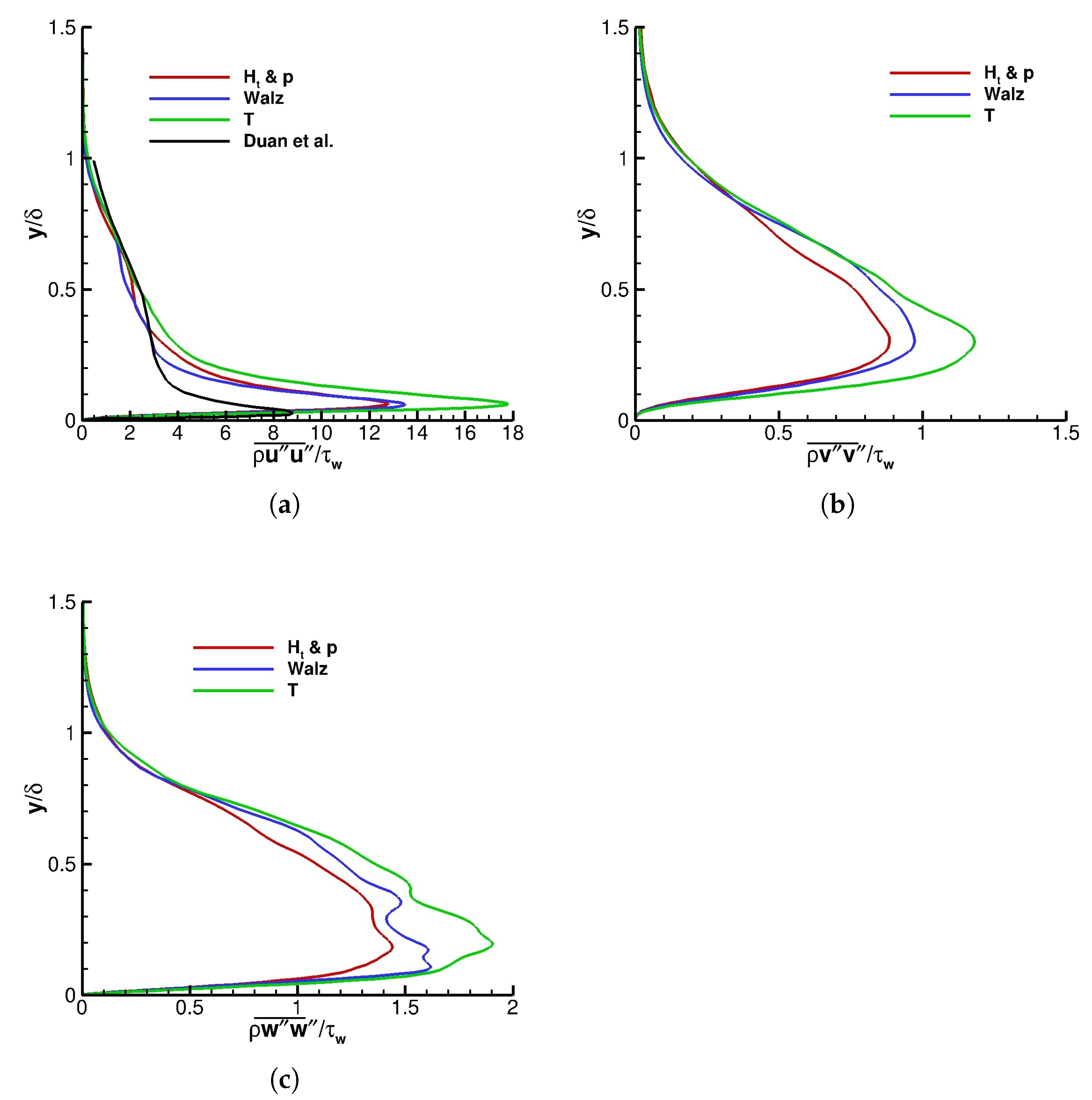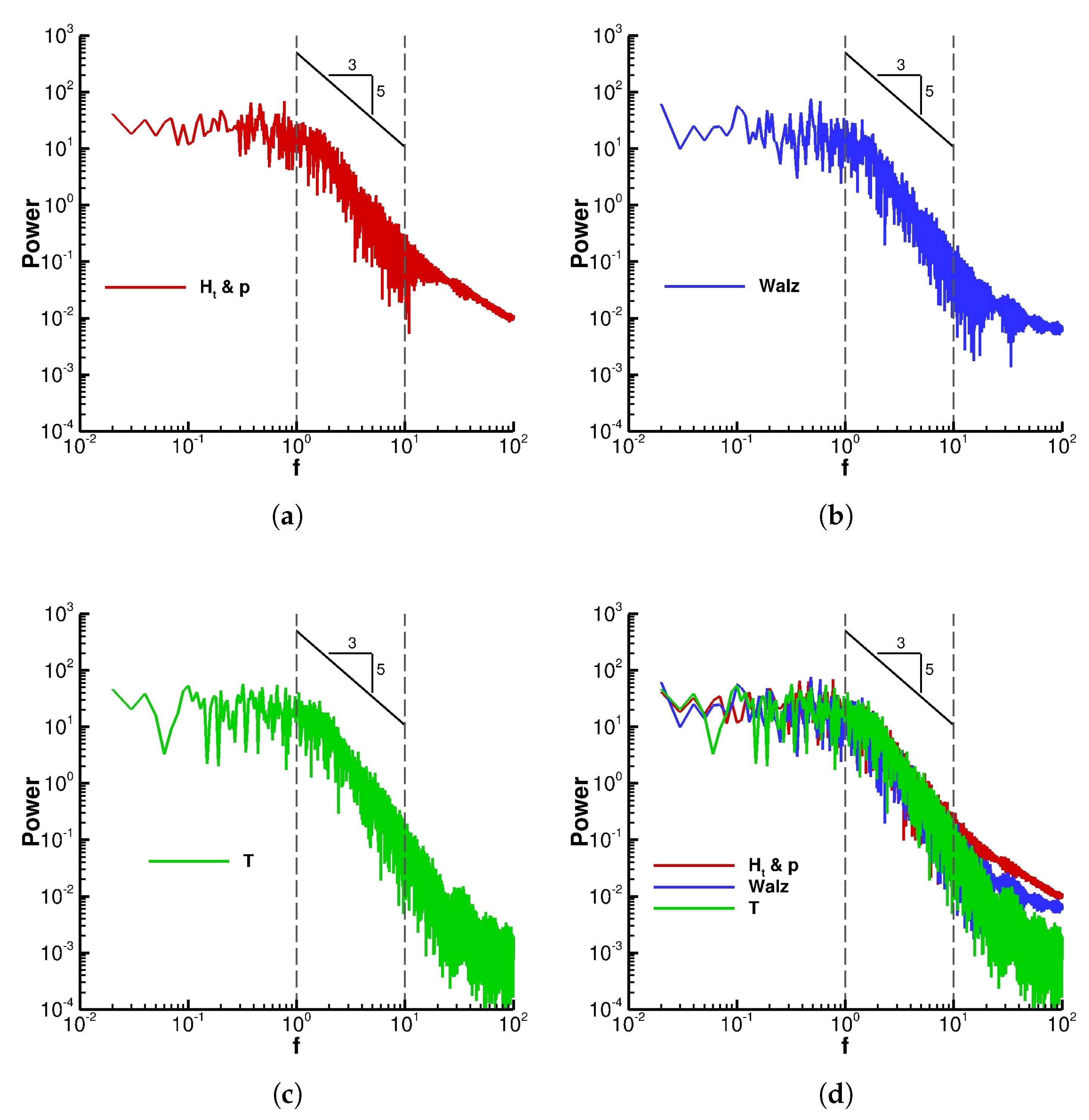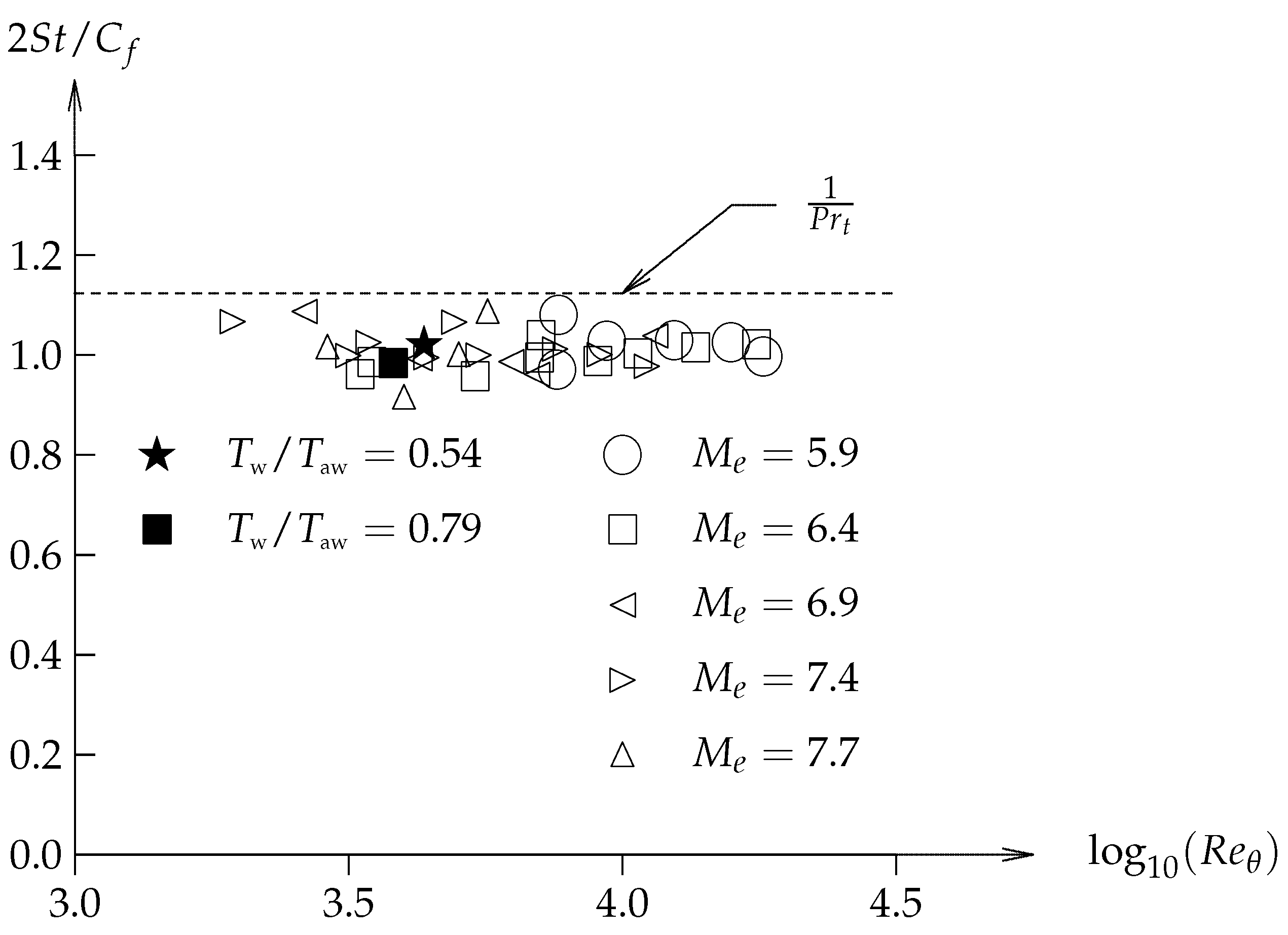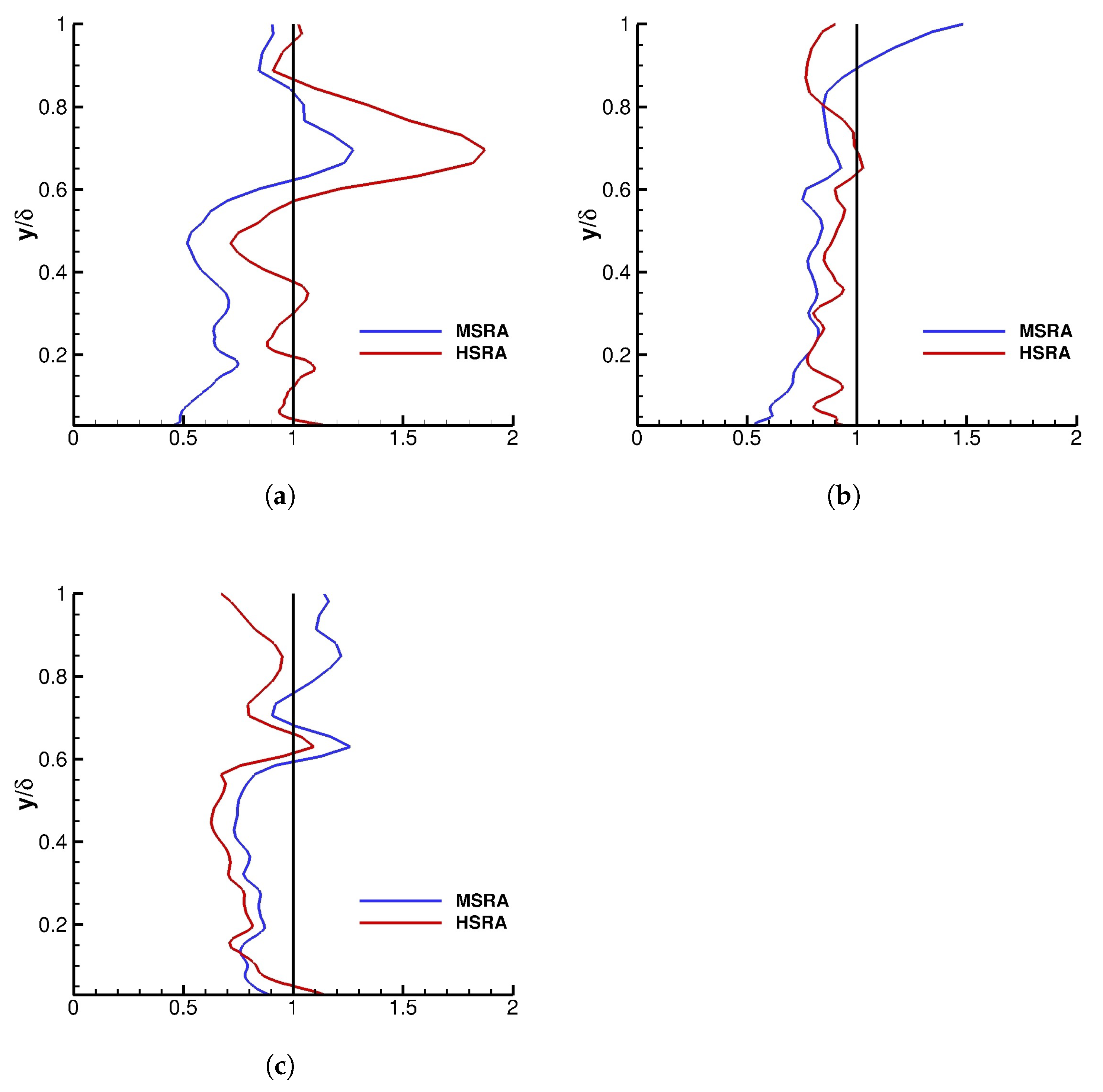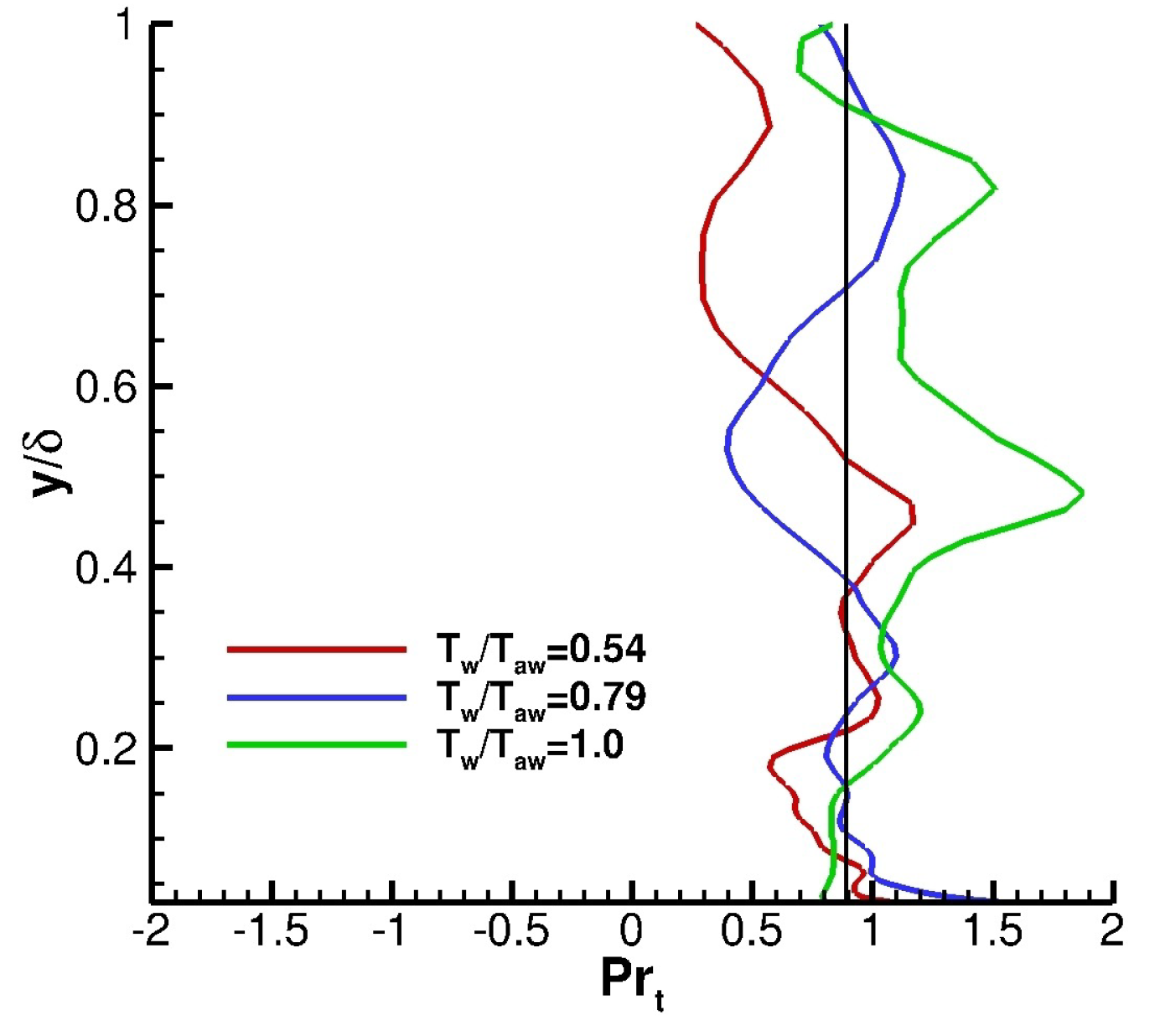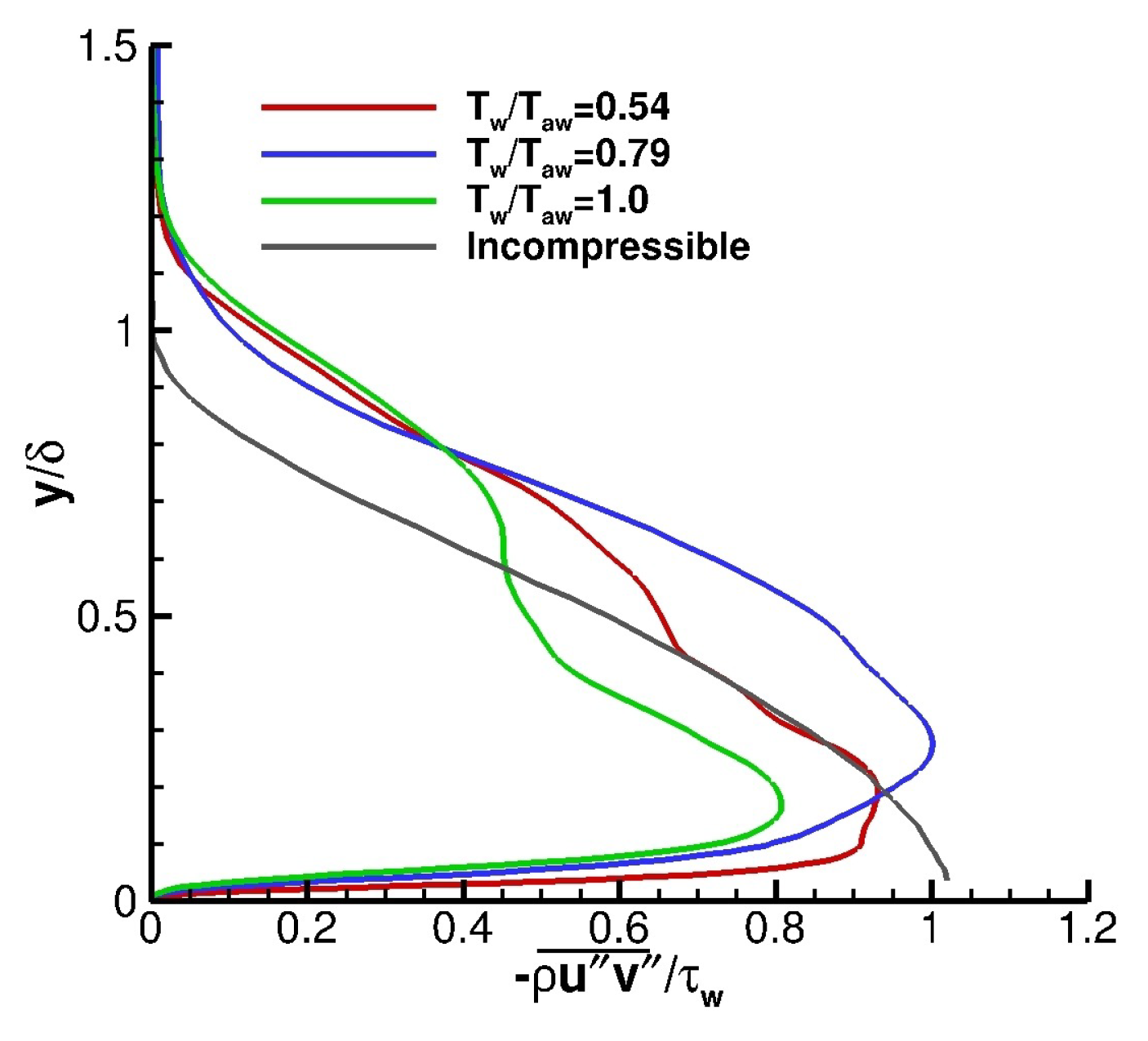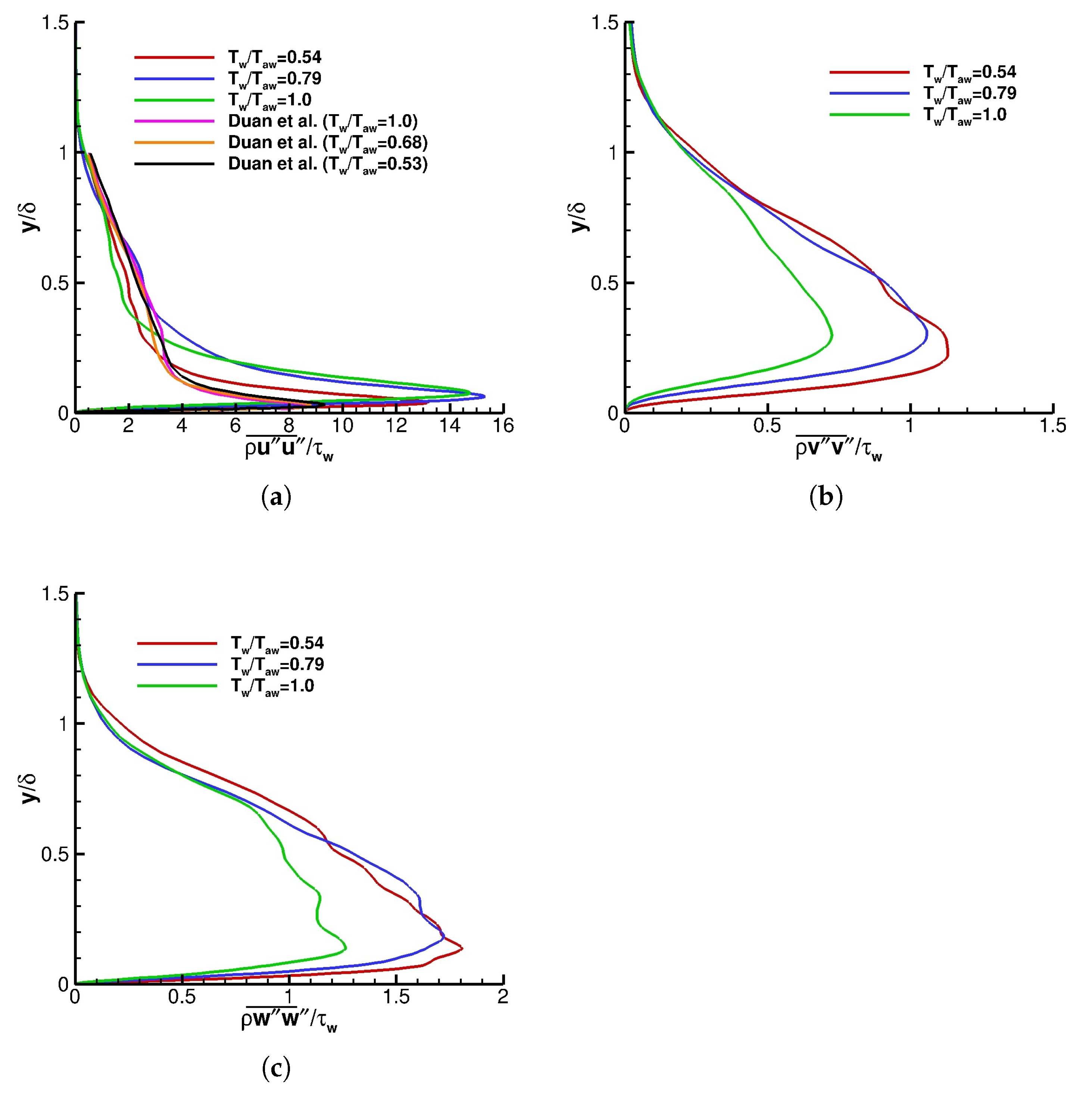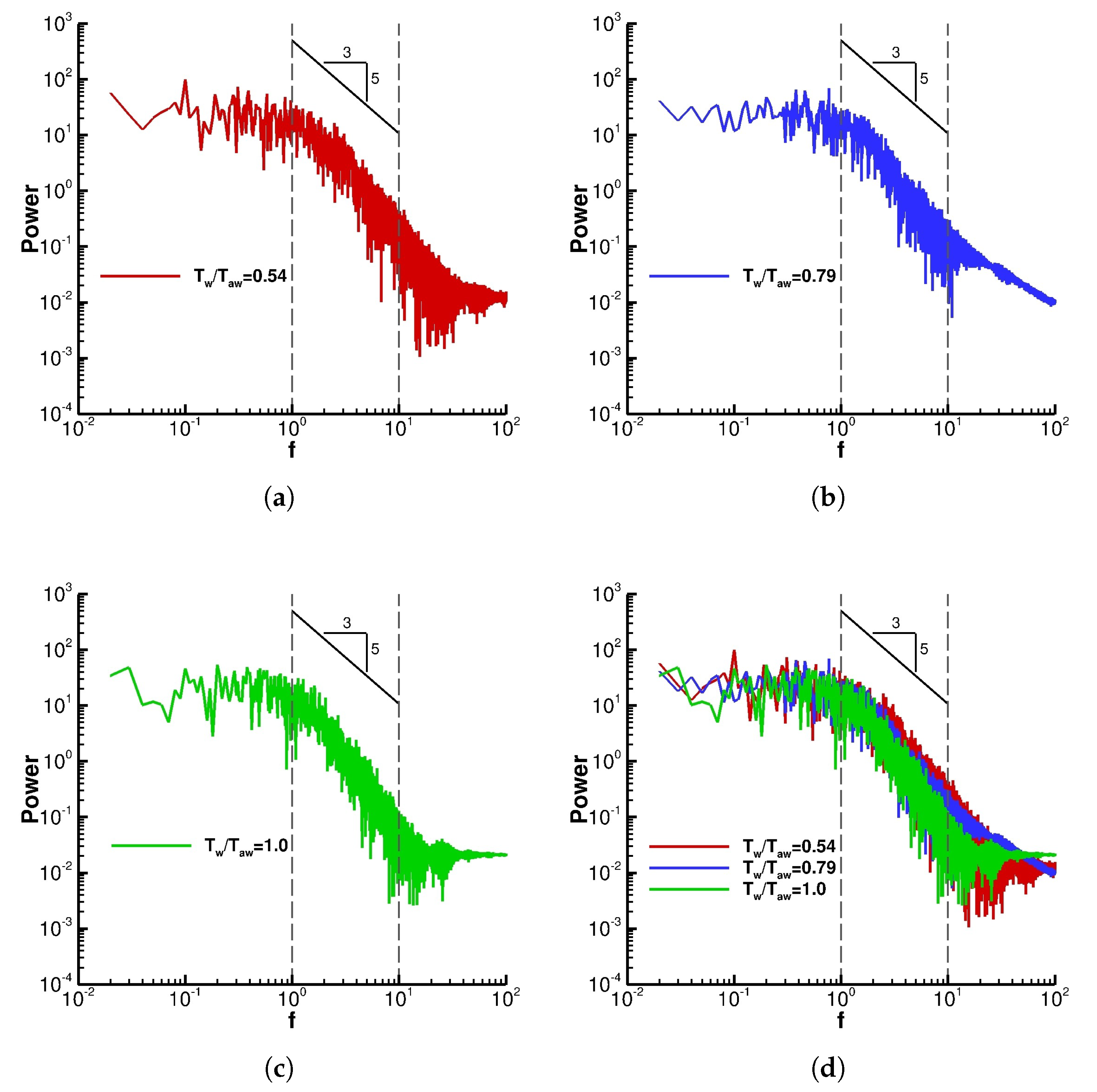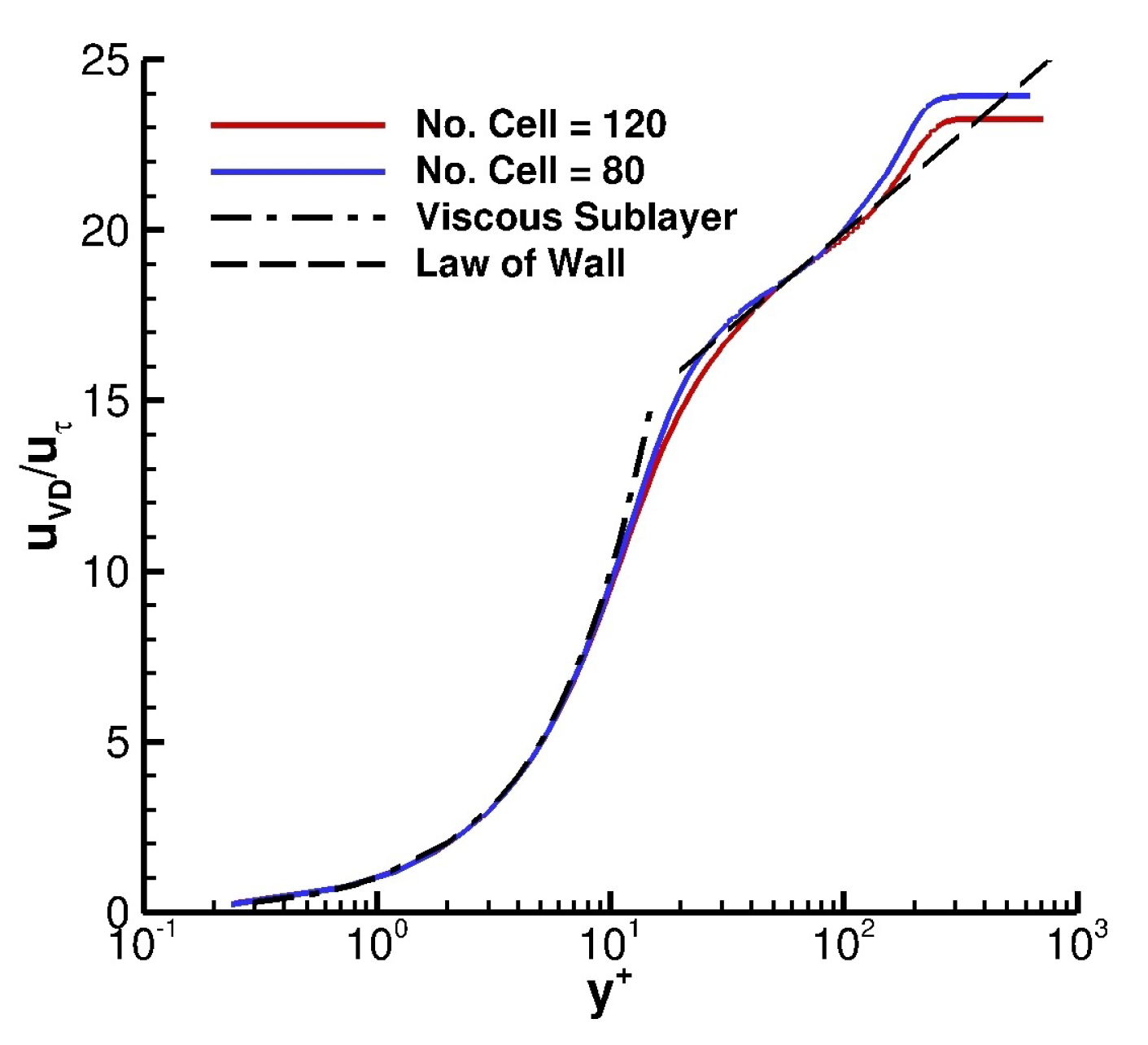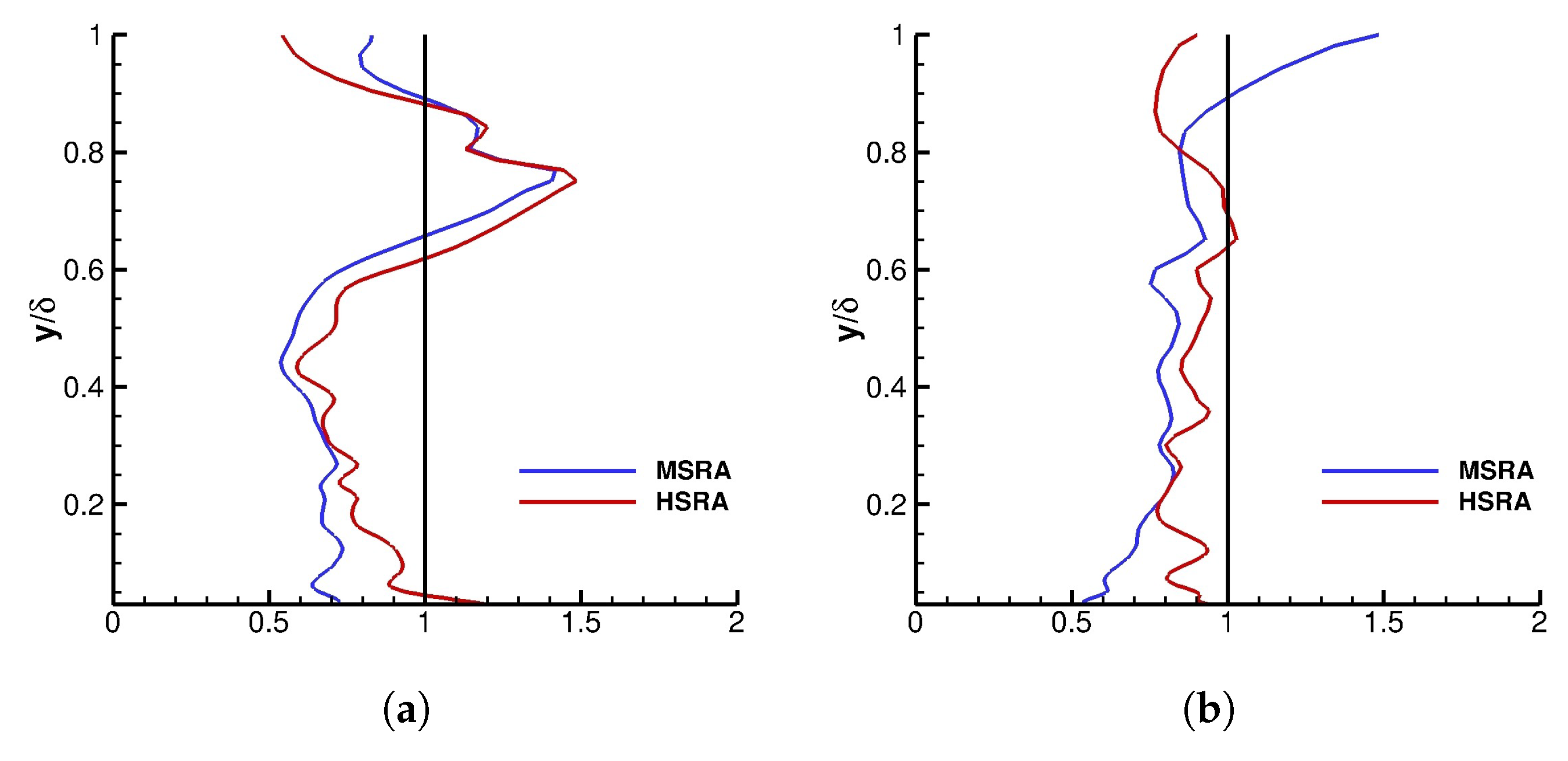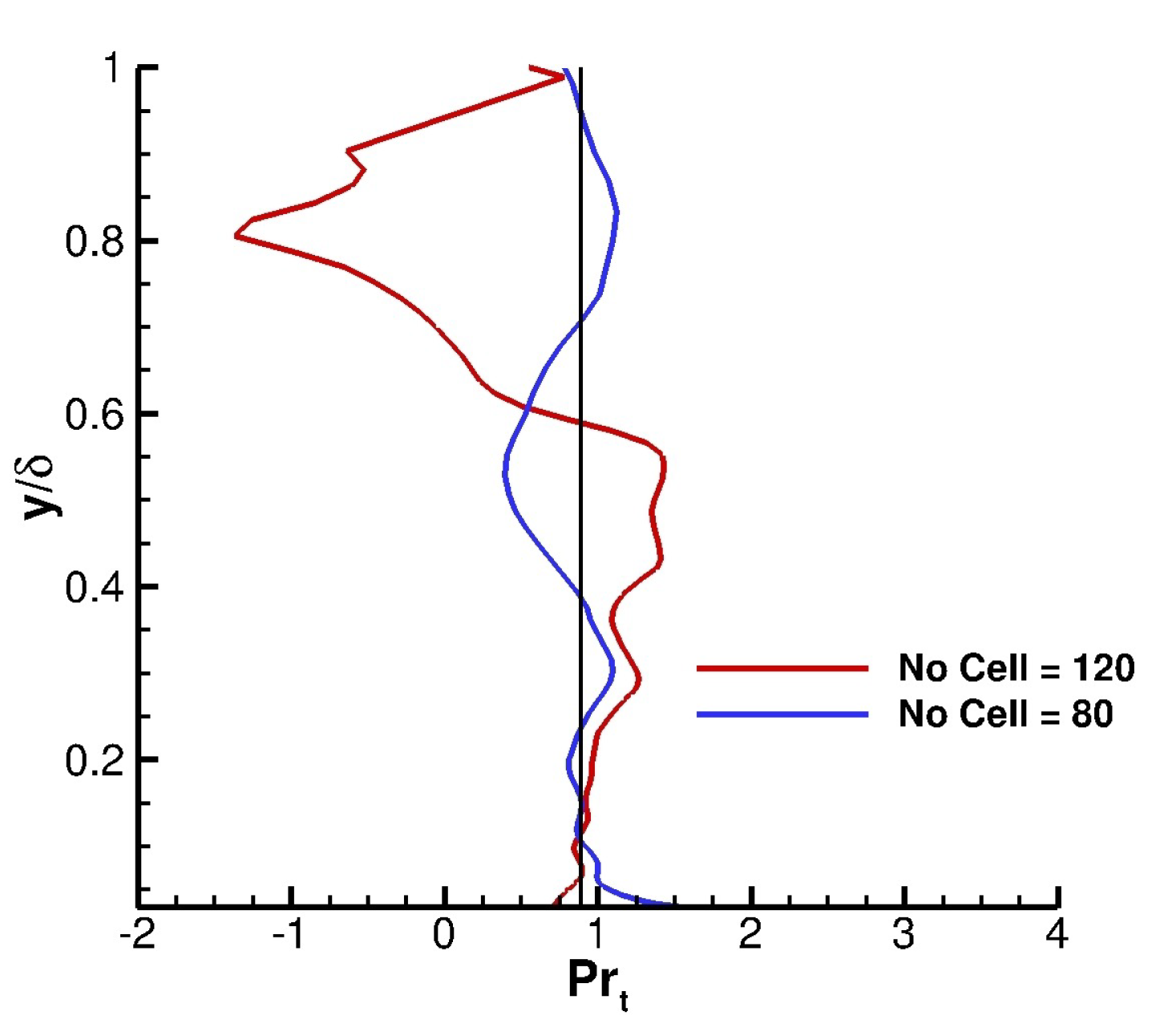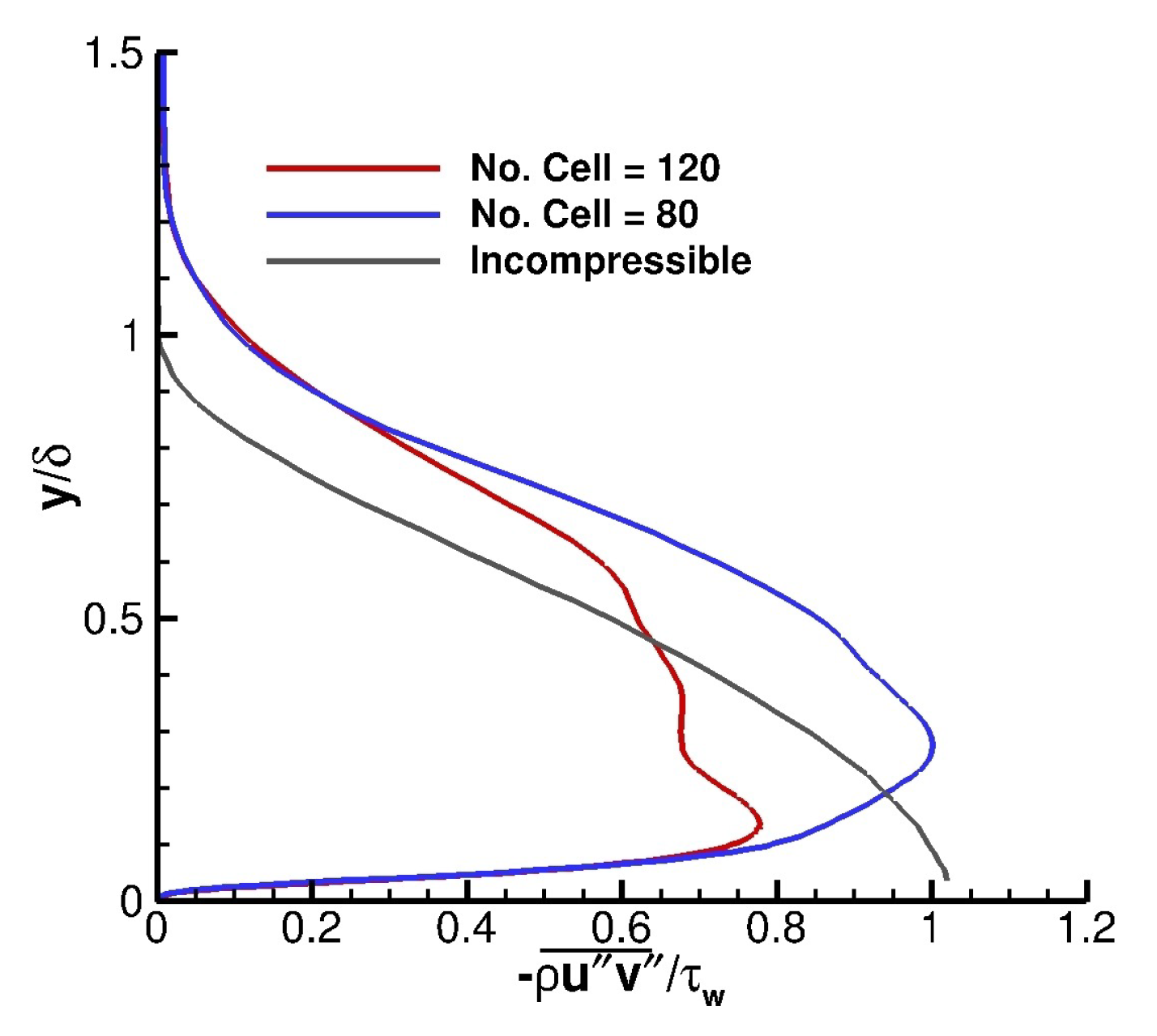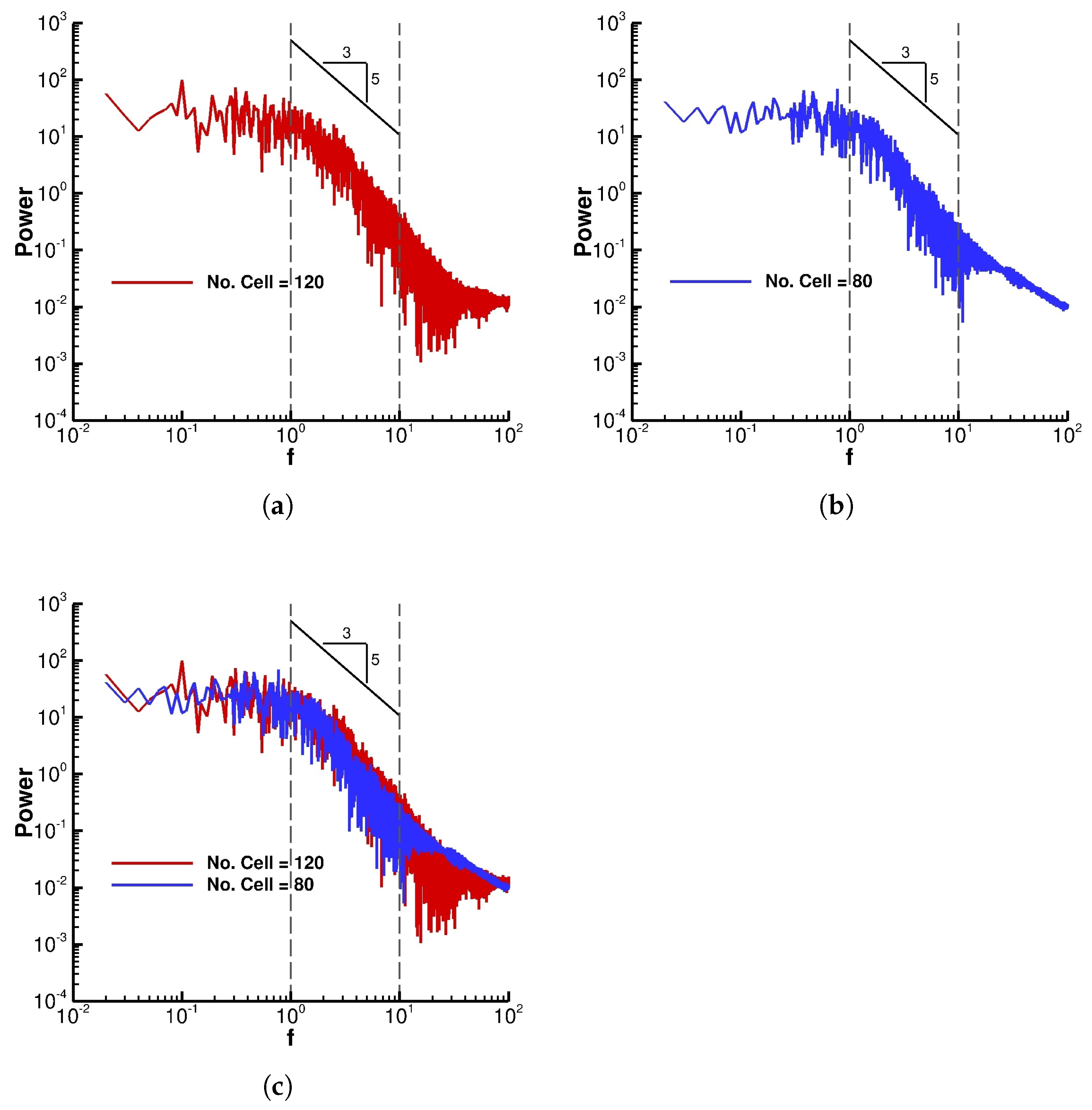In this section, we evaluate the effect of the three recycling-rescaling methods, the effect of wall temperature, and the effect of number of cells in the boundary layer. In
Table 2, the grid properties of the four grids used in this paper are present, where
,
, and
are respectively the dimensions of the computational region in the streamwise, wall normal, and spanwise directions. Grid 1 is used for freestream Condition 1, Grids 2 and 2(b) are used for Condition 2, and Grid 3 is used for Condition 3.
3.1. Effect of the Recycling-Rescaling Method
In this section the effect of the three different recycling-rescaling methods on the prediction of turbulent properties is examined. To do so, the freestream properties are the same as Condition 2 of
Table 1 and the grid is Grid 2. The calculated velocity profile, Reynolds Analogy Factor, Strong Reynolds Analogy, turbulent Prandtl number, dimensionless turbulent shear stress, turbulent normal stresses in streamwise, wall normal, and spanwise directions, and energy spectra are examined to evaluate the different recycling-rescaling models and the performance of the proposed method of
.
Figure 2 shows the calculated mean streamwise velocity and the Van Driest transformed Law of the Wall at
. The continuous lines are calculated mean streamwise velocity of the the three recycling-rescaling methods, namely
, Walz, and
T. The dashed-dotted line is is the Van Driest transformed velocity in the viscous sublayer, and the dashed line is the Van Driest transformed velocity of the Law of the Wall. The calculated mean streamwise velocity of all three recycling-rescaling methods agree well with the Van Driest transformed velocity of viscous sublayer and Law of the Wall.
Table 3 presents the Reynolds Analogy Factor of each recycling-rescaling method. The conventional value (
with
) is also provided.
Figure 3 shows the experimental scattering of Reynolds Analogy Factor versus Mach number [
39]. The calculated Reynolds Analogy Factors by the three methods are within the experimental uncertainty of experimental data.
To examine the effect of the recycling-rescaling method on the calculated Strong Reynolds Analogy, the Strong Reynolds Analogies proposed by Morkovin [
40] and Huang [
41] are selected. The Morkovin Strong Reynolds Analogy [
40] is
The Huang Strong Reynolds Analogy [
41] is
where,
and
.
Figure 4 presents the two Strong Reynolds Analogies evaluated at
. In each graph, the blue lines are the
, where
is calculated by
The red lines are the
, where
is calculated by
The black line is the line of constant value one. The closer the
and
are to the line of constant one (i.e., the black line), the better is the prediction. In general, Huang Strong Reynolds Analogy is a better estimate than Morkovin Strong Reynolds Analogy which is in agreement with the DNS results of Duan et al. [
42]. Importantly, the best agreement of the Morkovin and Huang Reynolds Analogy is for the
recycling-rescaling method.
Figure 5 shows the calculated turbulent Prandtl number by the three recycling-rescaling methods evaluated at
. The Prandtl number in a turbulent boundary layer is defined as
The black line in the figure is the constant Prandtl number of 0.89. The calculated turbulent Prandtl number of
and
T methods are closer to this line in comparison to the Walz method. According to DNS results of Zhang et al. [
43], although the turbulent Prandtl number is not constant in the boundary layer, it stays close to the conventional value of 0.89.
Figure 6 presents the calculated Morkovin scaled dimensionless turbulent shear stress (
) by the three recycling-rescaling methods at
. Additionally, for comparison purposes, the incompressible shear stress data of Klebanoff [
44] is also presented. The predicted Morkovin scaled dimensionless turbulent shear stresses are in general agreement with the incompressible data although the region with non-zero turbulent shear stress is smaller in the incompressible data. The Morkovin scaled dimensionless turbulent shear stress is zero at the wall, increases to its maximum value of about one at some distance near the wall and then reduces to zero at the edge of the boundary layer. The Walz and
methods predict the same maximum turbulent shear stress while the
T method predicts a larger maximum shear stress.
Figure 7 shows the predicted Morkovin scaled dimensionless turbulent normal stresses (
,
) respectively in streamwise, wall normal, and spanwise directions by the three recycling-rescaling methods at
. All the methods predict the same behavior for the turbulent normal stresses. In the outer part of boundary layer, the Morkovin scaled dimensionless turbulent normal stresses are essentially the same for all three methods. However, the
T method predicts the largest peak normal stresses for each of the Morkovin scaled dimensionless turbulent normal stresses while
method has the smallest peaks.
The comparison of the predicted Morkovin scaled dimensionless turbulent streamwise stress with the DNS results of Duan et al. [
42] shows a general agreement; however, the maximum stress is smaller for Duan et al. Further investigation is required to understand the reason behind this. It should be mentioned here that
for the presented result of Duan et al. is 0.68 while in our case,
is 0.79.
Figure 8 presents the energy spectrum of the total energy per unit mass of the three recycling-rescaling methods at
and
for the dimensionless time interval
. The inertial subrange for this problem is between dimensionless frequencies (
) of 1 and 10. From these graphs, all three methods predict the slope of the energy spectrum of
in the inertial subrange. The slope
is the theoretical prediction for the energy spectrum slope at the inertial subrange.
In summary, the introduced recycling-rescaling method has a better prediction of the turbulent properties. The method has the best prediction for Strong Reynolds Analogy and turbulent Prandtl number compared to the Walz and T methods and has comparable results for Law of the Wall, Reynolds Analogy Factor, turbulent shear and normal stresses, and energy spectrum. Therefore, the method is used for the recycling-rescaling in the rest of the paper.
3.2. Effect of Wall Temperature
In this section, the proposed
recycling-rescaling method is used to calculate the turbulent properties at different wall temperatures. Conditions 1 to 3 of
Table 1 are considered. The Grids 1, 2, and 3 of
Table 2 are used respectively for Conditions 1, 2, and 3.
Table 2 shows that the LES calculation becomes computationally expensive as the wall temperature decreases. Decreasing the wall temperature from adiabatic wall (
) to 0.54
, the grid spacing normal to the wall decreases by a factor of 2.13 to keep the same
.
Figure 9 shows the calculated Law of the Wall at
for the three wall temperatures. The continuous lines are the Van Driest transformed mean streamwise velocity at
of 0.54, 0.79, and 1.0. Additionally, the dashed lines show the Law of the Wall for each wall temperature and the dashed-dotted line is the Van Driest transformed velocity at viscous sublayer. The predicted Van Driest transformed velocity agrees well with the Van Driest transformed velocities of the viscous sublayer and Law of the Wall for all three wall temperature. Increasing the wall temperature increases the constant
C in the logarithmic region. The constant
C in the Law of the Wall is 7.2, 8.4, and 9.5 respectively for
of 0.54, 0.79, and 1.0. This trend is in opposition with the trend reported by Danberg [
32] as shown in
Figure 10.
Table 4 presents the values of the compressible turbulent boundary layer displacement (
) and momentum (
) thicknesses, as well as the shape factor
for all three wall temperature. Decreasing the wall temperature decreases the displacement thickness while increasing the momentum thickness and decreasing the shape factor.
Table 5 presents the Reynolds Analogy Factor for
of 0.54 and 0.79. Again, the conventional value (
) for Reynolds Analogy Factor is also presented in the table. The predictions are within the experimental uncertainty of available experimental data in the literature.
Figure 11 shows a sample of the Reynolds Analogy Factor from the literature where the open symbols are from Keener and Polek [
45].
Figure 12 shows the Morkovin and Huang Strong Reynolds Analogies for the three wall temperature
of 0.54, 0.79, and 1.0 evaluated at
. In each graph, the blue lines are the
calculated by Equation (
44), the red lines are the
calculated by Equation (
45), and the black lines are the constant value of one. The turbulent Prandtl number (
) is 0.89. In general, the Huang Strong Reynolds Analogy is a better estimate compared to the Morkovin Strong Reynolds Analogy. Moreover, the Huang Strong Reynolds Analogy is more accurate for the cold wall condition. In other words, the accuracy of Huang Reynolds Analogy is reduced by increasing the wall temperature, especially in the inner region.
Figure 13 shows the calculated turbulent Prandtl number (Equation (
46)) for the three wall temperatures. The black line represents the constant turbulent Prandtl number of 0.89. The calculated turbulent Prandtl number remains close to the constant line of 0.89, especially in the inner region.
Figure 14 presents the Morkovin scaled dimensionless turbulent shear stress (
) at
for three wall temperature
of 0.54, 0.79, and 1.0. The black line in the figure is the incompressible turbulent shear stress from Klebanoff [
44]. For all wall temperatures, the Morkovin scaled dimensionless turbulent shear stress is zero at the wall and increases by increasing distance from the wall until it reaches its maximum value and then starts decreasing until reaching to zero at the edge of the boundary layer. The results have the same behavior as the incompressible data; however, the region with non-zero turbulent stress is larger in the compressible results.
Figure 15 shows the Morkovin scaled dimensionless turbulent normal stresses (
) in streamwise, wall normal, and spanwise directions. Additionally, the DNS results of Duan et al. [
42] for the Morkovin scaled dimensionless turbulent streamwise stress for three wall temperatures are also presented. From the figure, in the outer region, the Morkovin scaled dimensionless turbulent normal stresses are independent of wall temperature. However, in the inner region, where the peak normal stresses are located, increasing the wall temperature decreases the maximum wall normal and spanwise turbulent stresses while increasing the streamwise turbulent stress.
Additionally, increasing the wall temperature moves the location of maximum turbulent streamwise stress away from the wall. It should be mentioned here that the Morkovin scaled dimensionless turbulent streamwise stress yields almost the same peak value and peak location for the of 0.79 and 1.0. However, the DNS results of Duan et al. shows no significant dependence to the wall temperature.
Figure 16 represents the energy spectrum of the total energy per unit mass at
and
over the dimensionless time interval of 100 for three wall temperatures. The range of dimensionless frequencies for the inertial subrange is 1 to 10. It can be seen that the slope of the energy spectrum in the inertial subrange for all the wall temperatures is
. This slope of
is what is expected for the inertial subrange in the theory.
3.3. Effect of The Number of Cells in the Boundary Layer
In this section, the effect of the grid is examined by changing the number of cells in the wall normal direction in the boundary layer. For this purpose, two grids, namely Grids 2 and 2(b) of
Table 2 are used for Condition 2 of
Table 1. The grids have the same
near the wall and then are stretched using geometric stretching until reaching the edge of the boundary layer. Grid 2 and 2(b) respectively have 80 and 120 cells in the wall normal direction in the boundary layer. The different number of cells in the wall normal direction means that the stretching factor is smaller in Grid 2(b) and thus, the grid cells are smaller in size in the boundary layer in comparison to Grid 2. Both calculations are performed using
recycling-rescaling method.
Figure 17 shows the comparison of the calculated Van Driest transformed mean streamwise velocity with the Law of the Wall at
. Additionally, the dashed line in the figure represents the Law of Wall, and the dashed dotted line represents the viscous sublayer. The calculated Van Driest transformed streamwise velocity of both grids are in good agreement with the theoretical values for Law of Wall and viscous sublayer. It is worth mentioning here that the
for both grids is essentially the same and the difference is less than a percent.
Table 6 shows the Reynolds Analogy Factor for the two grids with 80 and 120 cells in the wall normal direction in the boundary layer. Additionally, the conventional value of Reynolds Analogy Factor (
) is also presented. Both grids have the Reynolds Analogy Factor within the range of the experimental uncertainty in the literature (see
Figure 11).
Figure 18 shows the Morkovin and Huang Strong Reynolds Analogies for the two grids with 80 and 120 cells in the wall normal direction inside the boundary layer. In each graph, the blue line is the
calculated by Equation (
44), the red line is the
calculated by Equation (
45), and the black line is the line of constant value one. The turbulent Prandtl number in the Strong Reynolds Analogy is
. The Huang Strong Reynolds Analogy has a better result as expected. Surprisingly, the grid with 80 cells in the wall normal direction inside the boundary layer has better prediction of the Strong Reynolds Analogy compared to having a finer grid with 120 cells in the wall normal direction inside the boundary layer.
Figure 19 presents the calculated turbulent Prandtl number for the two grids with 80 and 120 cells in the wall normal direction inside the boundary layer. Additionally, the constant turbulent Prandtl number of 0.89 is also presented by a black line. In general, both grids have the Prandtl number close to the constant turbulent Prandtl number of 0.89. In the inner region, both grids have good agreement with each other; however, in the outer region the grid with 80 cells in wall normal direction inside the boundary layer stays closer to the constant line of 0.89.
Figure 20 presents the Morkovin scaled dimensionless turbulent shear stress (
) for the two grids with 80 and 120 cells in the wall normal direction inside the boundary layer. For comparison purposes, the incompressible dimensionless shear stress values of Klebanoff [
44] are also presented. Once again, the compressible data have a larger region with non-zero shear stresses. However, the compressible and incompressible data have the same trends. Moreover, the maximum shear stress is larger for the grid with 80 cells compared to the grid with 120 cells in the wall normal direction inside the boundary layer. It is worth mentioning here that the
for both grids is essentially the same.
Figure 21 shows the Morkovin scaled dimensionless turbulent normal stresses (
) in streamwise, wall normal, and spanwise directions for two grids with 80 and 120 cells in the wall normal direction inside the boundary layer. It can be seen that the thickness of the layer normal to the wall with non-zero normal stresses are the same for both grids. Moreover, the maximum values of the turbulent normal stresses decreases by increasing the number of cells in the wall normal direction. Comparison of the results with the DNS results of Duan et al. [
42] shows similar trend; however, the peak value of the wall normal stress is smaller in Duan et al. calculations.
Figure 22 presents the energy spectrum of the total energy per unit mass for two grids with 80 and 120 cells in the wall normal direction inside the boundary layer at
and
over the dimensionless time interval of 100. The inertial subrange for this problem is bounded by dimensionless frequencies (
) of 1 and 10. From the figure it can be seen that both grid predict the slope of
in the inertial subrange. This slope of
is the theoretical value for the slope of the inertial subrange.
